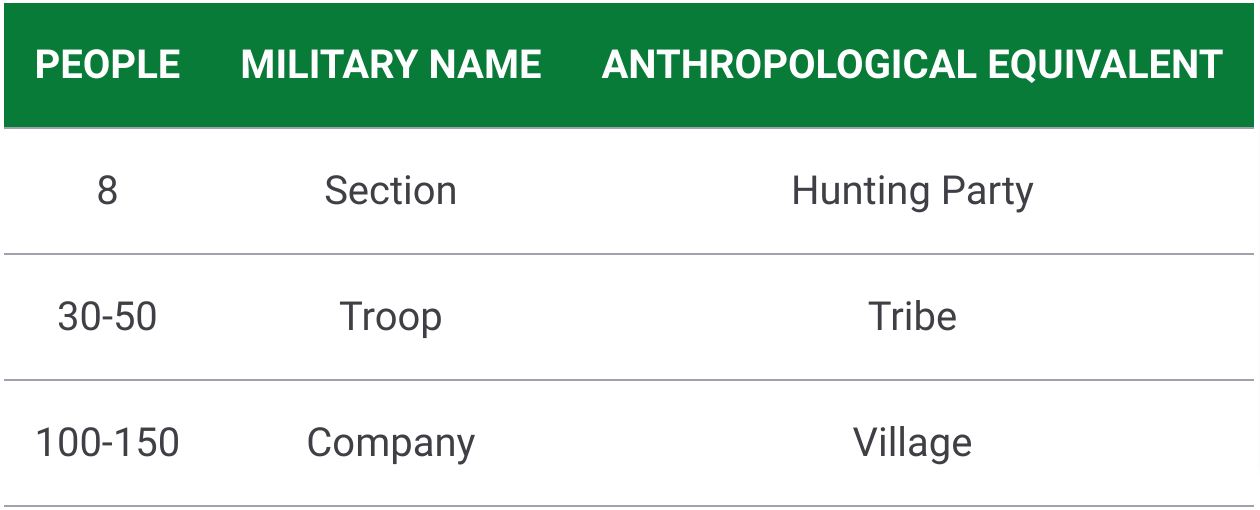Social Inflection Points
2020-02-09
There are inflection points in the growth of teams and organisations where behaviour changes very quickly. Interestingly these transition points happen around military sub-unit sizes, and the military is a good place to looks for clues on how to navigate these phase transitions.
Organisational size phase transition points

Section
In the Royal Marines the section is the basic unit. It’s made up of a commander and 2nd in command and 6 other men with various specialisations. 8 men in total who operate as a singe cohesive unit (but can also split down into two fire teams.
Troop (platoon in the army)
The next unit size is the troop. It’s made up of 3 sections, troop commander and sergeant, signaller and any attached units. The troop deploys its sections to complete missions. This is the first time we start to see the need for coordinating the efforts of smaller sub-units to achieve larger and more complex objectives.
Company
A company is pretty much where you have a self sustainable unit. It’s roughly 3 troops plus larger HQ element and attached capabilities dependent on mission. Company missions can be larger and more sustained, as well as being more complex.
A commando unit is made up of 3 fighting companies, plus supporting specialisations of signals, motor transport, heavy weapons etc etc.
Now what’s really interesting about this is that these structures are fractal. What’s even more interesting is that the process of coordinating across these different unit sizes shares the same structure. The orders and planning process for a mission that a section would take on is exactly the same in structure as a company operation. The company operation is divided up and the same process is then used at troop and section level to build a complete picture of WHAT everyone needs to do and more importantly WHY.
Now let’s compare these to a growing tech company.
You start with your founding team. You’re optimising for speed of learning and experimentation. You get things done as fast as possible, having (and needing) very little structure. You’re a section.
Fast forward past product market fit. You know what you’re building now (hopefully). Your sections are now your cross functional teams. You’re taking on longer running, more strategic pieces of work and coordinating multiple streams of work and competing priorities.
This is your first inflection point. This is where you start needing structure and consistency, but not at the expense of being able to get things done and ship. This is also where the seeds of success or dysfunction for scaling up start to be sown.
The next inflection point is when you’re trying to get to company size. You need a correspondingly larger leadership and HQ element. This is also the point where communications needs to be a lot more disciplined and structured.
Scaling badly
Trying to scale an organisation without having done the work of establishing structure and communications practices is painful. The default seems to be that this is left too late and companies attempt to bolt it on when things start to become uncomfortable. They might do this by hiring someone with experience, but it’s always tricky trying to retrofit culture that worked elsewhere.
What tends to happen is that practices and systems evolve haphazardly and are not given the attention required to change and adapt as the company grows. This tends to hit just when you want to accelerate and scale. Signs of this are:
- Unclear mission or priorities
- Delivery slowing down and a feeling of friction
- Siloing of teams and information
A great example of this is the spotify model. It’s a description of a set of practices that evolved in a particular context. There are certainly some useful fundamental principles that underpin it and it will work well with adaptation in many places.
Scaling well
Culture is an emergent property of the constraints applied to a group of people 1. It evolves with the organisation, and one of the most important jobs of a leader is to ensure that this process is nurtured and guided. The only way to do that is to create space around the work for reflection and improvement. To build Situational Awareness.
Lead like a gardener A gardener creates an environment that encourages growth. An environment full of light and nourishment. An environment with sufficient space for stretching and expanding. Leadership – and gardening – are all about creating positive change.
Gen. Stan McChrystal
The military has evolved a communications structure that balances operations with improvement really well. It’s the order and debrief process where operations are planned and learned from. I’ve adapted these processes for tech companies to help them navigate social inflection points as they scale.
Further reading